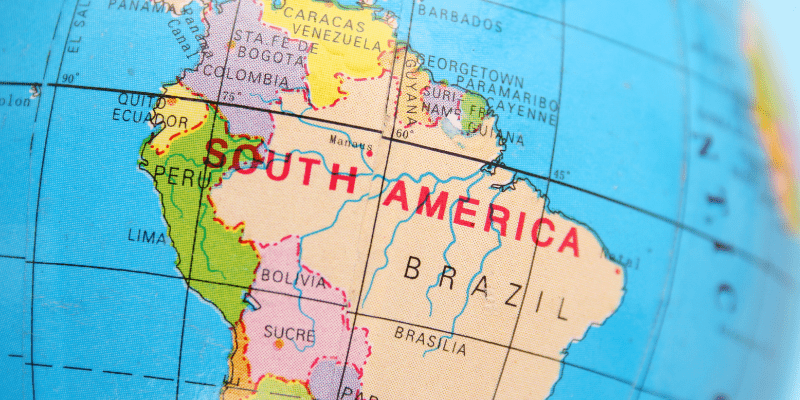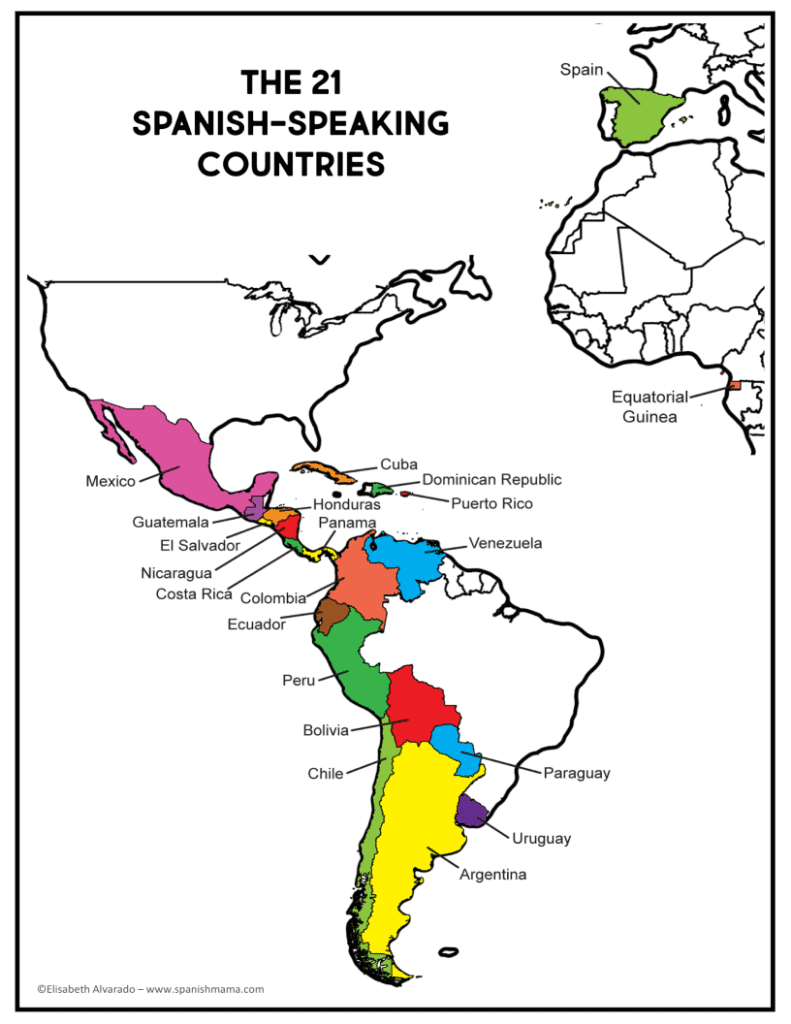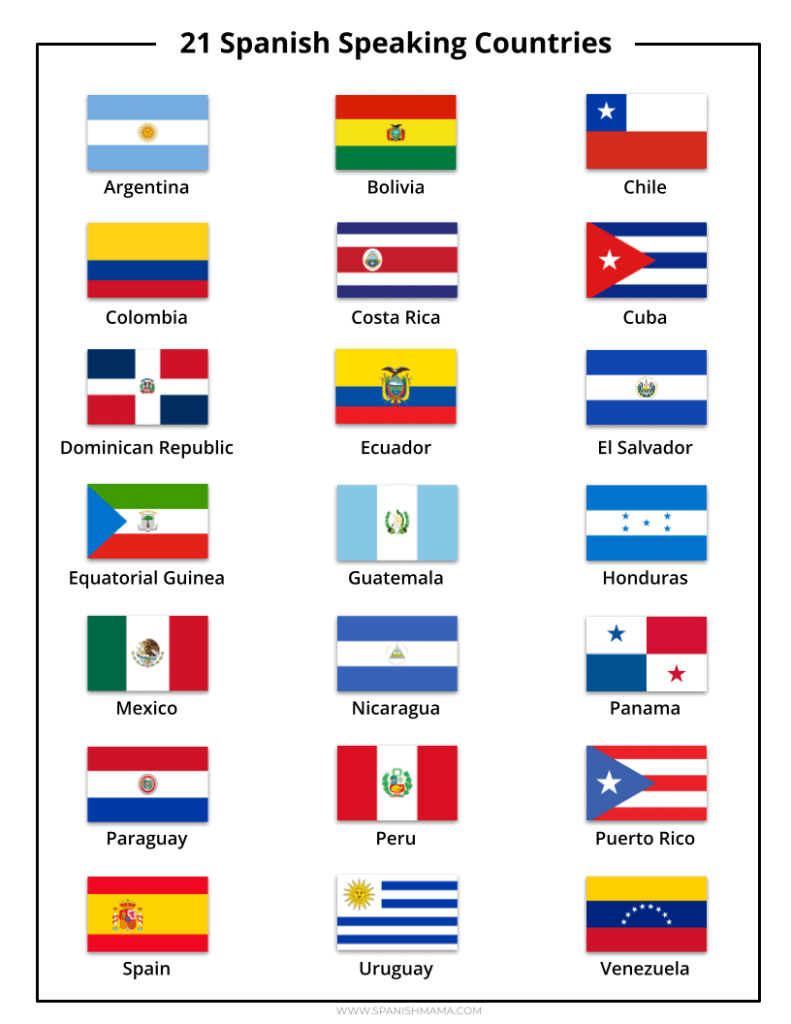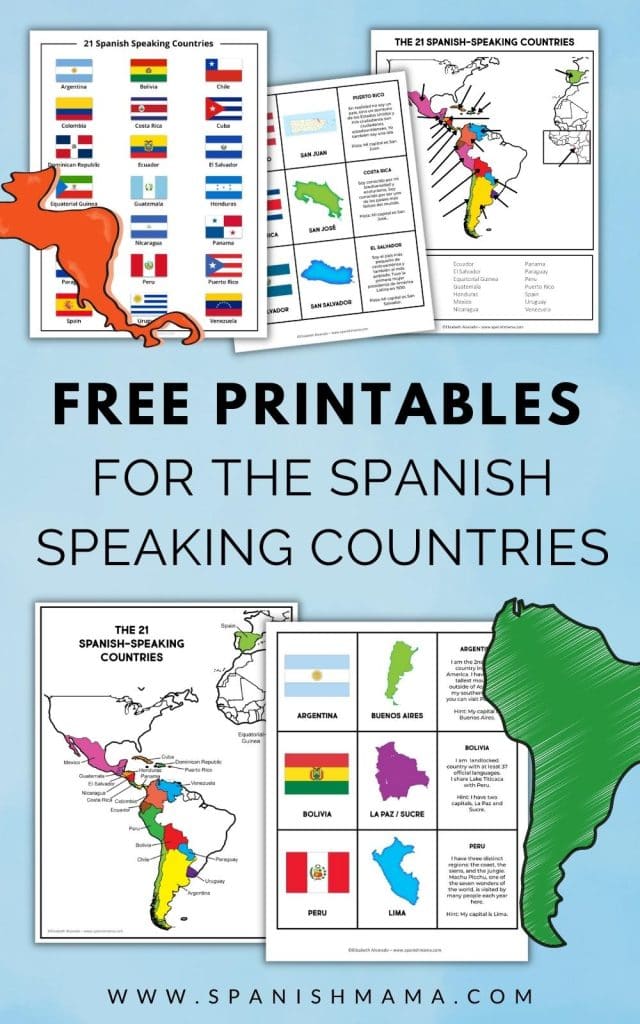21 Spanish Speaking Countries Map (Free Printable!)
Inside: Get a free printable map of the 21 Spanish speaking countries. Plus, see a list of their capitals, country flags, how to say the nationalities, and more.
The Spanish language spans four continents, as the official language of 21 countries.
With close to 500 million native speakers as of 2022, Spanish is the 2nd most-spoken language in the world after Mandarin Chinese.
Even though the United States is not an official Spanish language country, Spanish has a large presence there as well. According to Forbes magazine,
In the U.S., 13 percent of the population speaks Spanish at home, earning it the title of the most common non-English language spoken. The U.S. also has the 2nd largest population of Spanish speakers in the world (Mexico has the largest).
And the way the data is trending, by 2050, one in three people in the U.S. will speak Spanish (this data includes bilingual people who also speak English).
How Many Spanish Speaking Countries are there?
Some sources list only 20 Spanish language countries, as Puerto Rico is technically a commonwealth. While there’s some debate over this, I included 21 in my lists and maps. Those countries are:
- Argentina
- Bolivia
- Chile
- Colombia
- Costa Rica
- Cuba
- Dominican Republic
- Ecuador
- El Salvador
- Equatorial Guinea
- Guatemala
- Honduras
- Mexico
- Nicaragua
- Panama
- Paraguay
- Peru
- Puerto Rico
- Spain
- Uruguay
- Venezuela
Across these 21 countries, you can find a rich diversity of accents, usage of certain pronouns and verb forms, and local slang.
There is an especially marked difference between the Latin American accent and the pronunciation from Spain, though people from all of these places would understand each other just fine.
Related: Spanish Slang Phrases by Country
Free 21 Spanish Speaking Countries Map
If you would like a printable map for your students to fill or use, enter your email below and I will send to you right away.
To learn more, here is a list of contents:
1. Flags from the Spanish Speaking Countries
2. The 21 Spanish Speaking Countries and Capitals
3. Spanish Countries Nationalities
4. Videos for Learning the Spanish Speaking Countries
How Many Countries Speak Spanish?
Spanish is spoken in every part of the world, of course, by both native speakers and learners.
Here are some quick stats on where Spanish is spoken, regardless of being the official language.
Top 5 Countries By Number of Spanish Speakers (2021 source):
- Mexico
- Colombia
- Argentina
- Spain
- United States
(This data places the U.S. lower than the Forbes article cited above, and may reflect shifting changes in populations.)
Top 5 Countries by Spanish Language Students (2021 source):
- United States
- Brazil
- France
- United Kingdom
- Italy
Top 5 Non-Hispanic Countries by Percentage of Spanish Speakers:
- Aruba
- Dutch Antilles
- Andorra
- Belize
- Guam
Many people assume that Brazil, Belize, French Guiana, and/or Guyana are included, simply because they are Latin American.
Don’t be fooled– the official language of Brazil is Portuguese, English for Belize and Guyana, and French for French Guiana!
Flags from the Spanish Speaking Countries
Here are the flags that represent each country. If you would like a printable version, just click here.
Free Card Games for Spanish Students
These cards are now available as slides you can edit for your students or kids’ use! Enter your name and email below and I’ll send them right over.
The 21 Spanish Speaking Countries, Capitals and Continents, in English and Spanish
Here’s a list of Spanish-speaking countries for you to practice. Countries are listed alphabetically, by continent.
South America:
- Argentina – Buenos Aires
- Bolivia – Sucre and La Paz
- Chile – Santiago
- Colombia – Bogotá
- Ecuador – Quito
- Paraguay – Asunción
- Perú – Lima
- Uruguay – Montevideo
- Venezuela – Caracas
Central America:
- Costa Rica – San José
- Cuba – Havana
- Dominican Republic – Santo Domingo
República Dominicano – Santo Domingo - El Salvador – San Salvador
- Guatemala – Guatemala City
Guatemala – Ciudad de Guatemala - Honduras – Tegucigalpa
- Nicaragua – Managua
- Panama – Panama City
Panamá – Ciudad de Panamá - Puerto Rico – San Juan
Africa:
- Equatorial Guinea – Malabo
Guinea Ecuatorial – Malabo
North America:
- Mexico – Mexico City
México – Ciudad de México D.F.
Europe:
- Spain – Madrid
España – Madrid
Related: Songs for Learning the Countries and Capitals in Spanish-Speaking Countries
VIDEOS FOR LEARNING THE SPANISH-SPEAKING COUNTRIES AND CAPITALS
Here are some fun videos for memorizing the names or getting a peek into the culture and context of the Spanish-speaking world. For even more ideas, see my post on Hispanic Heritage Month!
BASHO AND FRIENDS
Learn the Capitals of Spanish-Speaking Countries.
LONELY PLANET KIDS
An introduction to the countries of North and South America in English, with interesting facts about each one (spoken, not a song).
Spanish Countries Nationalities, IN Spanish and English
- Argentinian– argentino/a
- Bolivian –boliviano/a
- Chilean – chileno/a
- Colombian – colombiano/a
- Costa Rican – costarriqueño/a
- Cuban – cubano/a
- Dominican – dominicano/a
- Ecuadorian – ecuatoriano/a
- Salvadoran – salvadoreño/a
- Equatorial Guinean – ecuatoguineano/a
- Guatemalan – guatemalteco/a
- Honduran – hondureño/a
- Mexican – mexicano/a
- Nicaraguan – nicaragüense
- Panamanian – panameño/a
- Paraguayan – paraguayo/a
- Peruvian – peruano/a
- Puerto Rican – puertorriequeño/a
- Spanish – español/a
- Uruguayan – uruguayo/a
- Venezuelan – venezolano/a
A Quick History of the Spanish language
As one of the five Romance languages, Spanish has its roots in Latin.
Spanish originated in the Iberian Peninsula as a dialect of spoken Latin, which is today called “Vulgar Latin,” as opposed to the Classical Latin used in literature. The dialect of Spanish that we consider dominant in Europe is called Castellano or Castilian Spanish.
During the Roman Empire, the Latin language was the official language on the peninsula (called “Hispania”), but it mixed with the local languages of the inhabitants, including Celts and Iberians, and began to take on its own unique flavor.
– Lingvist.com
By the 13th century, Spanish was becoming standardized and part of the administrative language of Spain. By the late 15th century, it had become the official language.
During the colonial period, it spread from Spain and became the official language of much of Latin America, and even one country in Africa.
Even though most of those former Spanish colonies had declared their independence by the 19th century, Spanish by then was the dominant language for government matters. Many indigenous languages were marginalized or lost.
From Rosetta Stone,
… the history of Spanish is a complex one as Spanish didn’t always naturally develop as the language of choice for these millions of people. In reality, the tongue’s use is the product of centuries of history, the majority of which concerns turbulent periods of migration and colonization.
From Spanish-speaking countries in Africa to Spanish-speaking countries in Asia, the number of Spanish speakers across the world is growing. According to the Pew Research Centre, in the US alone, the number of speakers has grown by an enormous 233% since 1980, and looking globally, the Cervantes Institute predicts that the population in officially Spanish-speaking nations is predicted to reach 750 million by 2050.













Costa Ricans are called costarricenses.
These resources are AMAZING! Thank you so much for creating them!